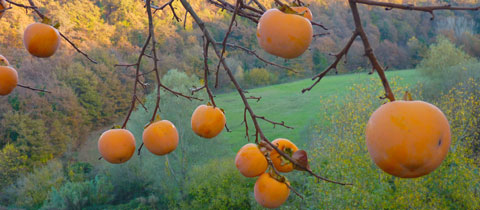 |
 |
|||
CdP
16 November 2015
The other day I found my so-called gardener beneath the crooked little manna ash in the car park, shaking it vigorously and bringing down a thick shower of purply leaves around him. I expressed surprise, and quite a lot of disapproval. “But they’re so messy,” he said. “If I don’t shake them down, they just fall off.”
I soon put a stop to that.
They are falling, and they are certainly making a mess. But they are glorious – particularly for a couple of late-sunset moments each evening when it’s very important to be outside. Lights seem to switch on in each of the Chinese-orange coloured balls – and there are so very many of them this year – on the persimmon trees, and the autumn leaves flash impossible colours. Then darkness falls.
Only these warm windless days (and my timely interventions) are keeping the leaves in place: if one breath of wind blew, it would put an end to this marvellous palette. The weather is slightly greyer now, and our valley is occasionally full of mist, but it continues to be fairly warm, utterly rain-less and still as still. Smoke from our woodburners (lit in the evenings) or from the bonfire I set going the other afternoon (I never quite finished because a huge toad kept lolloping from one bit of unburnt biomass to the next as I pitched forkfuls off the pile and on to the flames: I left him with a small lump of cover at the end) just belches straight up into a slightly resistant sky.
We were in Rome last week. It was the first time in ages that I enjoyed a Rome trip. So often lately I’ve been hugely dismayed by the squalor of a city that really isn’t at its best.
This time we drove straight in (no negative public transport experiences: that helps), stayed and ate in a wonderful hotel (JK Place Roma: excellent), I saw three exhibitions (Palazzo delle Esposizioni: very much on form), then we left. A grand total of about 16 hours: that’s more or less the optimum length for a visit to the city these days, I reckon.
I headed for the PalaExpo thinking that the show of Impressionist works from the Phillips Collection (Washington DC) would be good. I mean, Impressionists: you can’t really go wrong, can you? But in the event, that was the least rewarding of the three shows on at present – perhaps, unfairly, because of the sour-faced guide I watched illustrating a Cezanne work to a class of seated seven-year-olds, who slapped down a keen child who dared respond to one of her loaded questions with his own impressions rather than the plodding answer she was clearly expecting. There. That’s one child that will never bother to show enthusiasm for art and galleries ever again. Brava signora.
But it was also because the other two exhibitions were gripping. All right: Italian design 1900-1940 was bound to contain some gems, and it did… some quite amazing pieces and paintings. But it was the least likely sounding show (Russia on the Road, 1920-1990) that I found utterly charming and quite mesmerising: whoever would have thought that Soviet portrayals of cars, trucks and things that go could be so wonderful? There was, in many of the works, such an innocent delight in means of transport, and breathless admiration of those at the wheel. It was propaganda painting, obviously, but with something almost of the child-with-new-train-set joy in many. Fascinating.
He may call himself a gardener, but as frequently mentioned, I rate my occasional outside help not very highly in that department: his plant knowledge is limited, to say the least, and his obsessive tidiness instinct trumps his aesthetic sense every time – hence his assault on my superb autumn colours. But applied correctly – as in strimming banks or clearing brush – that same tidiness is a boon, especially as it is coupled with huge doggedness, great strength and a strong work ethic.
This, presumably, is what landed him a huge job clearing a large stretch of newly bought land over by Lake Trasimeno somewhere, the property of foreigners who want eventually to bring it into their existing garden which was landscaped by a friend of mine. So big was this job, that my so-called gardener invested in equipment and employed two helpers – paying their National Insurance contributions and making them 100% legal – before diving in. Only to be handed a paltry cash sum – far less than agreed – after an initial couple of days’ work.
Quite desperate (he stood to lose money at that rate), he asked me to ask my landscaping friend to intervene with the owners. Because here in this case it was not vulnerable foreign workers being exploited by unscrupulous Italians, but Sri Lankans ripping off their own.
I get so angry when I hear of people exploiting people. There is one young Romanian around here – a real workhorse who’s punctual, honest and very thorough – who asks for €5 an hour, to make sure that he gets lots of labouring and gardening work. (He was immensely embarrassed when I refused to let him work here unless he accepted more. I had to tell him that I didn’t want anyone worth so little helping me.) Those same locals who will moan about foreigners coming over here, taking our jobs, will, if given half a chance, gleefully pay someone way less than the pathetic figure which is generally considered the lowest acceptable rate (€8 an hour). Is it any wonder that locals, who tend to want €10 or €12 for similar tasks and considerably less effort, find it hard to get their neighbours to employ them? The irony seems to be lost on most people.
My so-called gardener’s unfortunate situation has resolved itself now, and he’s a happy worker once again. But I have to admit that in some contorted way I found myself feeling relieved when I realised that it wasn’t only the natives who treat their fellow men so badly. Of course what I should have been feeling is despair over the fact that callousness is so universal and all-encompassing…